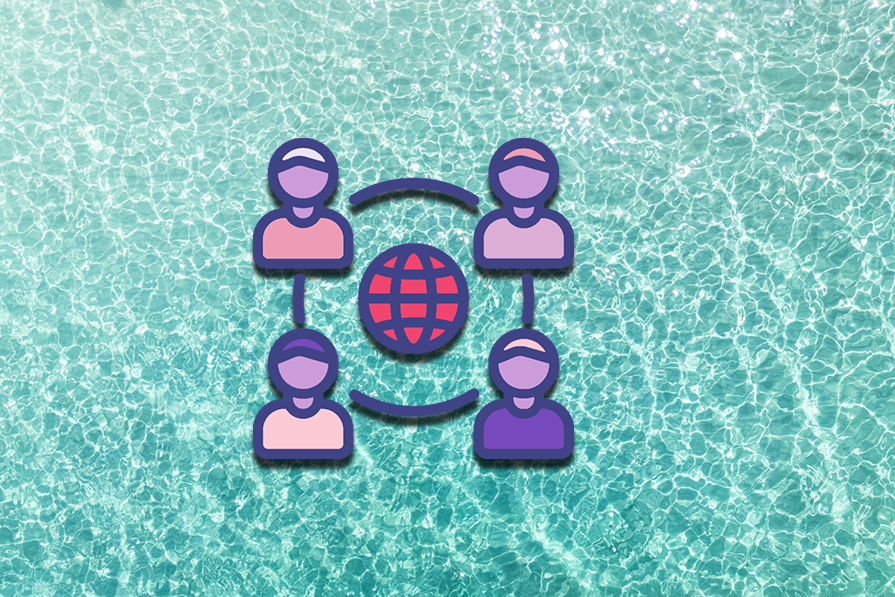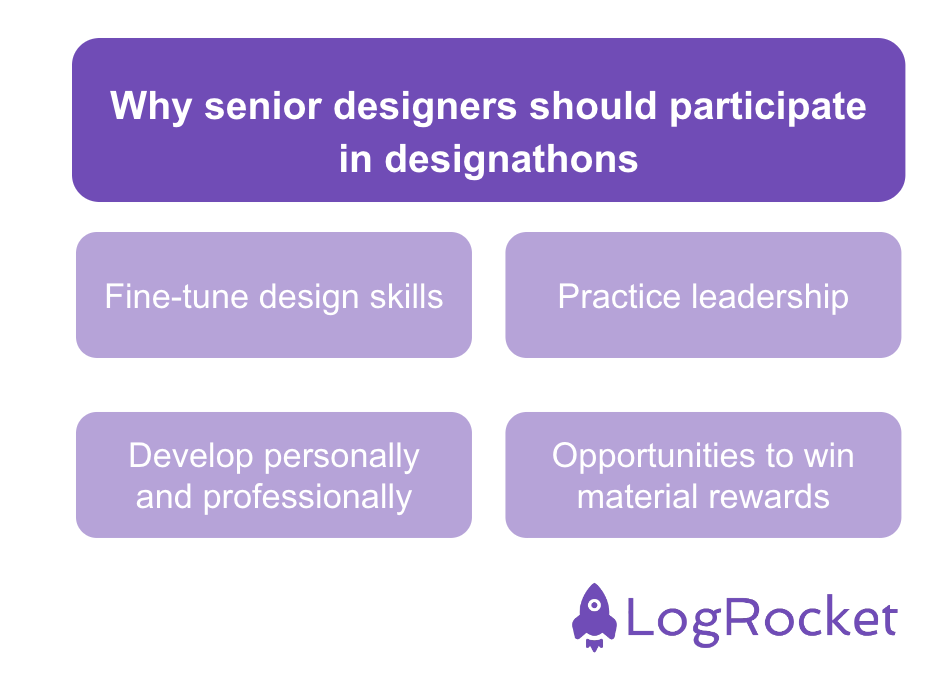Tech professionals are likely familiar with the term hackathon — a once- or twice-a-year event where engineers gather for 24–48 hours nonstop to build something totally new. The goal of often solving a tech or business problem that doesn’t exist today.

Usually, the result of hackathons is basic MVPs that may evolve into a new feature or a new technological improvement and will enhance the backends of a digital product. Since the products are mostly unfinished or in basic development, they need to be coded and ready to showcase.
In comes a new type of design-oriented hackathons called designathons. In this article, we’ll talk about what designathons entail, the soft and hard skills they develop, and learnings from my personal experience as a seasoned designer participating in designathons. Specifically, we’ll talk about how attending designathons as a veteran designer can be crucial to building best practices and organizing projects with junior peers.
Similar to a hackathon, designathons bring design professionals from all levels and backgrounds gather — sometimes with guests such as project managers, developers, or researchers. The final goal is to find and design a solution to a business problem that generally comes from a customer need.
Participants have the same amount of time as a hackathon, and they participate in brainstorming sessions, user research, and user testing to iterate a realistic prototype. That prototype is then shown to stakeholders in the hopes of winning their vote and the opportunity to turn the concept into a real, coded development.
While hackathons and designathons may have different outcomes, both of them are centered around a culture of collaboration and team cohesion. It’s a great way to enhance the creativity and problem-solving mindset of the team.
Take it from me — although participation in designathons is not mandatory, these events help senior designers improve in various areas:

First, participating in a designathon will put the designer in a position to practice all their skills under time constraints and pressure. This specific scenario will help shape skills such as resilience, communication, and organization. It’s been great for my personal hard skills as well, such as prototyping, flow creation, and designing new screens.
A soft skill that may be relevant to put into practice during these times is leadership. Designers who are willing to transition from individual contributors to people managers may find this to be a perfect scenario. They get a low-stakes way to lead and mentor junior designers through problem-solving exercises. It’s also a good opportunity to give feedback and mentorship to junior designers.
An experienced designer can find designathons to be great places for personal and professional growth. They can see their ideas and abilities develop over time as they attend more designathons, and even include their outputs in their portfolio for future reference. Further, companies often tend to be conservative in terms of design and development, but when it comes to designathons, teams are free to experiment with new ideas and technologies.
Successfully winning a designathon often comes with recognition and prizes, such as money or sponsorship. Sometimes, companies provide interesting rewards, such as opportunities to collaborate, that make the challenge more interesting.
However, in my opinion, none of these are as important as the camaraderie and team bonding built during a designathon. It’s a unique time to create community engagement and the feeling that everybody is part of a unified mission. There’s also usually time set aside for networking and expanding professional relationships.
As someone who has participated in multiple designathons, here are a few of the main learnings and benefits I was able to take away from the experience:

Product design requires adaptability to constant changes, with requirements and acceptance criteria often changing. During a designathon, you can experience and work on this skill, as it happens often during the event.
Product designers and project managers usually have to work together to present and sell the concept to stakeholders. Having prepared a good presentation with data, a developed solution, and metrics to use will help the team argue to get the budget to develop the concept.
During a designathon, you can learn or improve the design framework you like to work with. It’s a good time to put into practice new exercises and fine-tune the process. Experimentation is always welcome here since it’s not a real-life project with stakes like budgets, time, etc.
Resilience is maybe the most important skill for every designer, as well as all professionals in any field. Designathons can be mentally draining and require you to focus and concentrate. Through these exercises, you can develop resilience by facing different challenges and emerging as a better designer.
Even if you are a senior and experienced designer, connecting with people from other backgrounds and industries may help you expand your horizons. Bringing together people quite different from each other is an opportunity to create something new and, who knows, a potential fit for a future job search.
Nobody likes to fail or to be rejected. Still, you have to learn to participate and fail. Even if you work hard, not everything depends on you and your skills. Sometimes, it’s not your day to win, and you take the learning with you and try again soon. As they say, you learn more from a failure than from a winning.
In the end, winning is not what matters here. A designathon is a celebration of the design culture of the community, gathering together, working, learning, and achieving.
Experienced designers can face multiple challenges during a designathon, as they are the ones with a higher responsibility in the team. They need to be the leads and need to guide junior colleagues, promoting inclusivity and a culture that welcomes open-mindedness.
The most important lesson I offer you is to be a leader, not a boss. It’s a challenge and a constant learning to be a good leader, particularly one that helps and mentors others instead of giving orders. A leader listens and provides solutions to peers in need, where bosses hand out specific directions. Create a collaborative environment, without fear, and contribute to having the freedom to do great things.
Further, not knowing the right answer is another challenge to face. A senior or veteran designer may not know everything, so being unfamiliar with an industry or a technology during a designathons is normal.
Lastly, practically speaking, time is a big challenge to consider. It’s limited, and veteran designers must plan for a fast-paced process. They need to prioritize tasks and allocate resources while maintaining the quality of the outcome. Making critical decisions under time pressure is not an easy thing.
Teams at designathon, just like teams at your regular job, vary in form and size. There is no specific rule for setting the number of participants, a common structure is usually 10 or more. We’ll talk about that scenario in detail.
Groups are usually made by a few designers and other professional roles such as researchers, data analysts, developers, and project managers. Collaborating in a group of this size may require solid team structures and specific roles for each one of the participants.
At the beginning of the day, it is important to set the team’s structure. A flat and horizontal structure is a common and recommended pattern, but it is still important to set one or two people to lead the team. These individuals will own the process, organize tasks, and take ownership of the result. The rest of the team will be individual contributors with different levels of expertise, working together to find the best possible solution. The professionals with more seniority will lead the different initiatives of the project, mentoring and guiding the junior team members.
At the beginning of the designathon, it’s important to establish common goals and have a clear vision and structured roadmap of what is going to happen in the following hours. Time is limited and the pressure is high, meaning it is important to know the outcome the team is looking for and the process to follow to achieve it. Therefore, it is fundamental to have clear communications throughout the process, including an open channel to raise concerns and clear out possible conflicts.
Conflicts may arise in large teams easily, so establishing a process to resolve conflicts with an assigned mediator can help fix disputes quickly with a positive outcome. Every team member must feel integrated and respected.
Also, some people may feel like they’re in the shadows and intimidated by their peers, so it is important to generate an atmosphere where everybody is welcome to participate and no idea is wrong. Leadership and senior team members can coordinate all the stages of the project and put together the parts created by the different working teams to have a final polished presentation. Preparing an outstanding presentation for stakeholders requires the team to rehearse, distribute the sections of the presentation, be calm, and have fun.
Not everything ends at the conclusion of the designathon. There are a few things that come right after it. Let’s take a look at different tasks and events that will happen later:
It is important to mention that designathon events are a celebration of design organized by companies, communities, or individuals. Mixing ingredients such as collaboration, problem-solving, and creativity, designathons offer a unique opportunity for seasoned designers to improve their hard and soft skills while mentoring junior designers.
Despite it being a complex journey, the outcome is great —leaving a high impact on the community and yourself as a designer. Sometimes, as professionals grow in their professional careers, they step aside from these intense initiatives. But, as we discussed, designathons are not only for junior designers! Seasoned designers can definitely find an opportunity through these events to evolve and grow in expertise and maturity.
LogRocket's Galileo AI watches sessions and understands user feedback for you, automating the most time-intensive parts of your job and giving you more time to focus on great design.
See how design choices, interactions, and issues affect your users — get a demo of LogRocket today.

Small actions can have large consequences in complex systems. Here’s how UX designers can manage dependencies so users feel informed and in control rather than blocked or blindsided.

This article examines when hero sections are necessary in digital products, when they create friction, and how to evaluate them using UX goals, primary actions, user flow impact, and real-world alternatives.

AI speeds up tasks like research synthesis, ideation, and first-draft wireframes, but it can’t replace clarity, taste, or decision-making. Here’s a grounded look at what AI actually does well in UX right now.

Discover how to craft UX-friendly hero sections with examples, design tips, and strategies that drive engagement and conversion.